by Dave Weber, images by Doug Breithaupt |
Billed as the only US made sports car at the time, the Corvette made its appearance in 1953. The basic design was presented in four different body styles in the experimental GM Motorama dream car display early that year. The styles consisted of the soon to be introduced production roadster, a hardtop coupe introduced later in 1956, a Nomad sports wagon, introduced in 1955 in the Bel Air line as a full size car, and a fastback model called the Biscayne which never entered production. These cars toured the nation during 1953 and 1954. In the meantime, the Chevrolet Division began mass producing the roadster model which had only slight changes from the experimental car. The small air scoops on the front fenders were removed . The side chrome strip was lengthened and inverted. Only 300 cars were produced that first year. All had white plastic bodies with red and white interiors. This basic body style now called the C-1 remained in production with some changes through 1962. It was replaced by the more radically styled Sting Ray or C-2 model in 1963. Before entering into a survey of the various 1/64 (3 inch ) models found over the past quarter century, I believe a brief summary of the annual styling changes should be presented. This can assist the collector to properly identify the year each of his models may represent. Some years had more pronounced styling changes then others. Some models can possibly represent more then one specific year. Other styling changes were so minute that they are unable to be portrayed on a miniature model of this size. 1954 was the first full year of production. The fiberglass body was offered in 4 colors. Most of the cars were painted Polo White, but the Pennant Blue was also a popular color. Sportsman Red was also available and 6 cars were finished in black. There were no visible styling changes for this year. 1955 was the first year that a V-8 engine was offered. It replaced the 105 horsepower Blue Flame Six. Again, there were no major styling changes. However, the side-script of the V-8 models had an enlarged V placed over the "Chevrolet' name. The first major styling change occurred in 1956. The bird cage headlight housings and the rocket taillights were eliminated. The dual exhausts were repositioned outward from under the trunk area to protrude out of the rear bumper at the rear of each fender. The side panels were scalloped at the front wheel wells. This style remained basically unchanged until 1958. 1958 was the second major styling change to the C-1. Dual headlights and partial covers over the previously introduced fender scallop design were added. This was the last major change until 1961. The only visible change in 1959 consisted of the removal of fake hood louvers. There were no visible changes in 1960. In 1961 the Corvette sported a new rear fender 'duck tail' styling which was a hint of the Sting Ray to appear in 1963. Also in 1961, the teeth in the grille were replaced by a mesh screen and the headlight rims were painted in body color. The coved scallops still featured 3 large fins. The 1962 model eliminated the chrome outline around the scalloped cove on the body and replaced the 3 fins in the reverse fender scoops with a grid . Also the mesh grille was blacked out and an anodized aluminum strip was added to the rocker panels. Now we can review the models representing this marque for the first 10 years of its life. By listing each product in chronological order, I can provide an overview of all known toys and models for each specific year. |
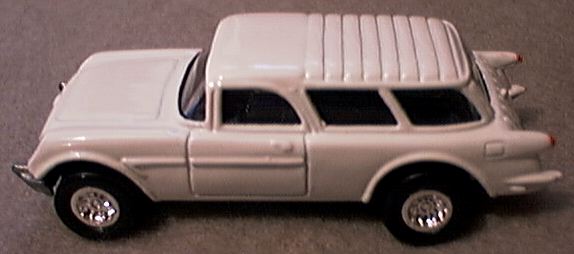 Johnny Lightning #P171 1953 CORVETTE 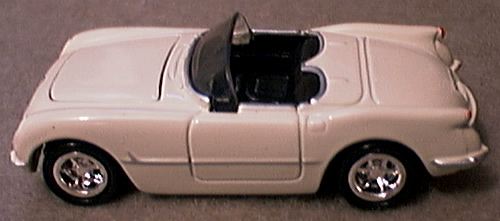 Johnny Lightning #731  Kidco #151 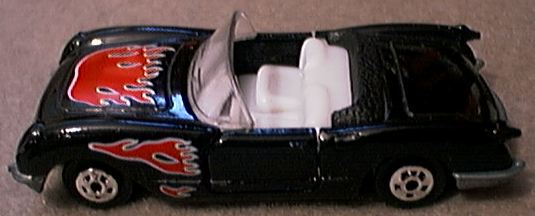 Road Champs 1954 CORVETTE 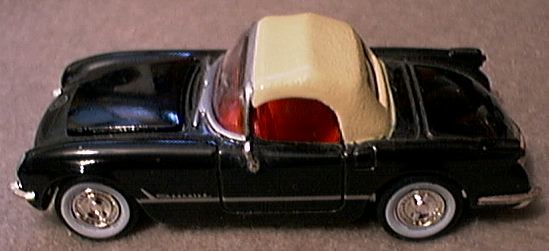 Racing Champions #3 1957 CORVETTE  Yat Ming #1079 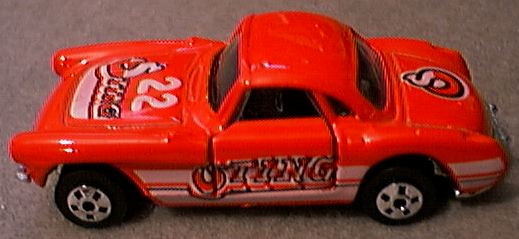 Road Champs 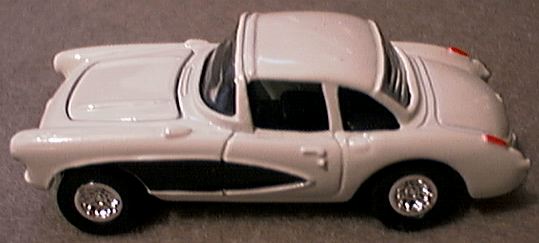 Johnny Lightning #P166 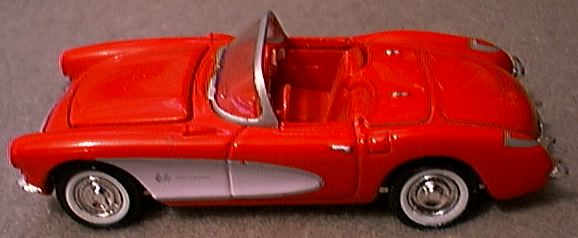 Racing Champions #173  Welly #2064 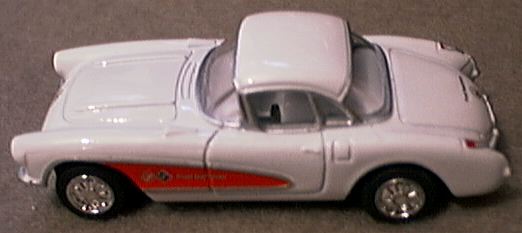 Kinsmart 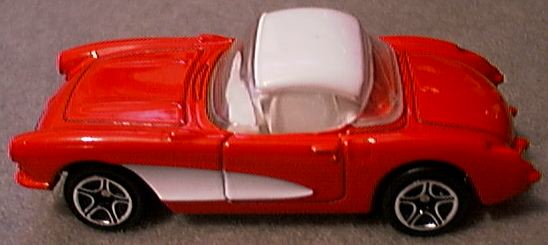 Matchbox |
Motorama (1953 - 1954) 1953 1954 1955 - To date no models have been issued. 1956 1957 1958 1959 1960 1961 This completes my review of the C-1 phase of the Corvette. I hope to continue with a summary of the C-2 Sting Ray next month. Historical Research material was obtained from Corvette Past- Present- Future by the editors of Consumer Guide (1982). |
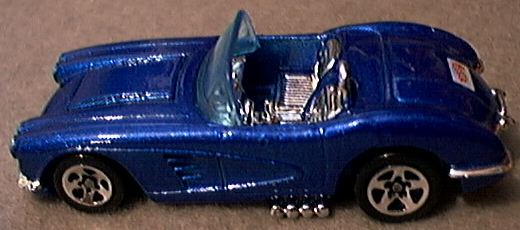 Hot Wheels 1960 CORVETTE 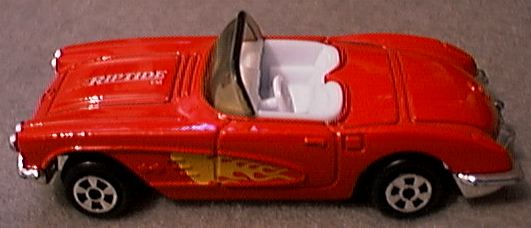 Ertl #7356 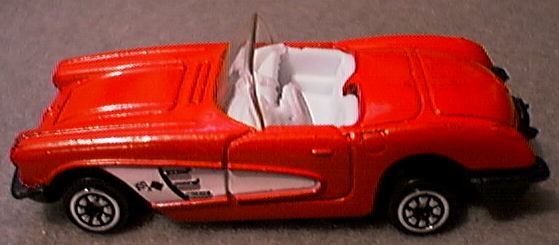 Tootsietoy 1962 CORVETTE 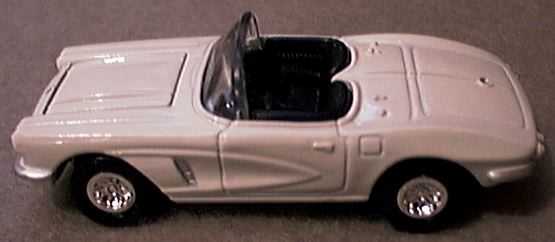 Johnny Lightning #P167 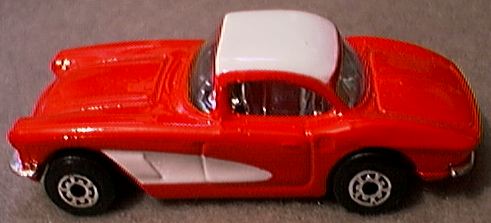 Matchbox (regular issue) 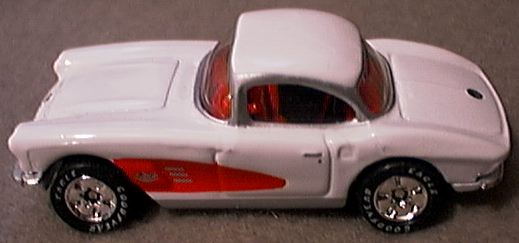 Matchbox (Premier Edition)  Matchbox (These racing colors are certainly one of the best looking with the lace-style wheels and the orange/white scheme.)  Matchbox has certainly made use of their '62 Corvette with 16 different color variations shown here. The front row, with one exception, are all Premier Edition/World Class models as is the black, chrome-engined model in the back row. The exception is the red/white 'Animal House' model. 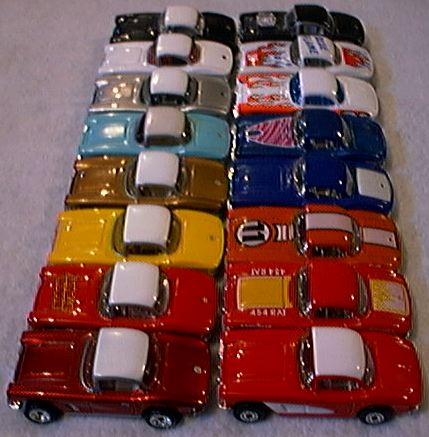 A total of 16 color variations maybe close to a record for small-scale cars. Of course, busses and trucks with different messages or advertising would total many more. If there is a car with more variations, let me know (click here) For articles on the Corvette C-3 and C-4 models, please use these links. |